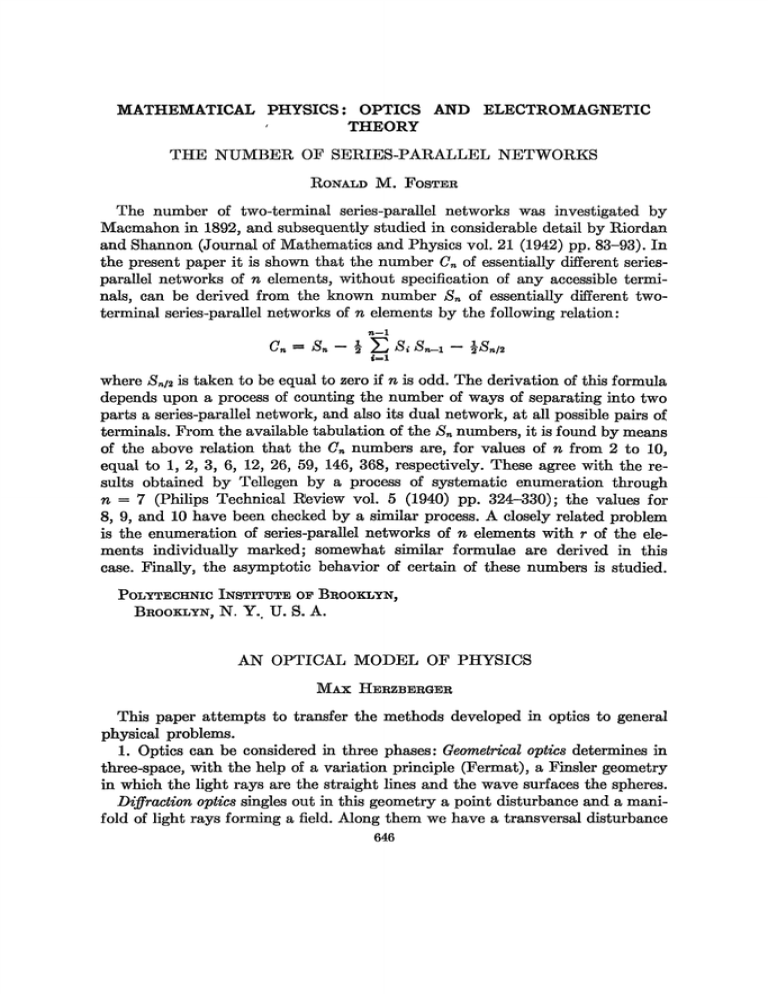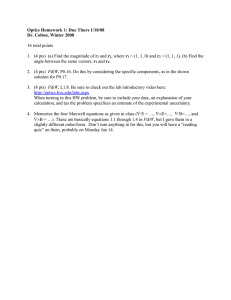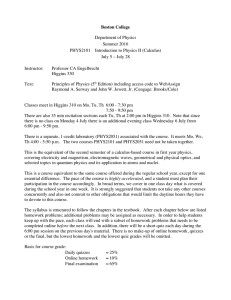The number of series-parallel networks
advertisement

MATHEMATICAL PHYSICS: OPTICS AND ELECTROMAGNETIC THEORY T H E NUMBER OF SERIES-PARALLEL NETWORKS RONALD M. FOSTER The number of two-terminal series-parallel networks was investigated by Macmahon in 1892, and subsequently studied in considerable detail by Riordan and Shannon (Journal of Mathematics and Physics vol. 21 (1942) pp. 83-93). In the present paper it is shown that the number Cn of essentially different seriesparallel networks of n elements, without specification of any accessible terminals, can be derived from the known number Sn of essentially different twoterminal series-parallel networks of n elements by the following relation: n-l where Sn/2 is taken to be equal to zero if n is odd. The derivation of this formula depends upon a process of counting the number of ways of separating into two parts a series-parallel network, and also its dual network, at all possible pairs of terminals. From the available tabulation of the Sn numbers, it is found by means of the above relation that the Cn numbers are, for values of n from 2 to 10, equal to 1, 2, 3, 6, 12, 26, 59, 146, 368, respectively. These agree with the results obtained by Tellegen by a process of systematic enumeration through n = 7 (Philips Technical Review vol. 5 (1940) pp. 324-330); the values for 8, 9, and 10 have been checked by a similar process. A closely related problem is the enumeration of series-parallel networks of n elements with r of the elements individually marked; somewhat similar formulae are derived in this case. Finally, the asymptotic behavior of certain of these numbers is studied. POLYTECHNIC INSTITUTE OF BROOKLYN, BROOKLYN, N. Y.. U. S. A. AN OPTICAL MODEL OF PHYSICS MAX HERZBERGER This paper attempts to transfer the methods developed in optics to general physical problems. 1. Optics can be considered in three phases: Geometrical optics determines in three-space, with the help of a variation principle (Fermât), a Finsler geometry in which the light rays are the straight lines and the wave surfaces the spheres. Diffraction optics singles out in this geometry a point disturbance and a manifold of light rays forming a field. Along them we have a transversal disturbance 646 OPTICS AND ELECTROMAGNETIC THEORY 647 of given frequency characterized by an axial vector. Huygens' construction (Green's Theorem) gives the value of the disturbance vector at a given point, If, because of absorption, the wave surfaces are "in phase" but with different amplitudes, the diffraction effect can be calculated. (The superposition of diffraction effect from a finite number of disturbances gives a sufficient approximation to optics.) Absorption and emission are concerned with the selection of frequencies due to the vibration of the emitting and absorbing elements. The Einstein effect can be explained by the eigenvalue theory of the modified wave equation. 2. Physics can be considered in three parallel phases in Euclidean spacetime: A variation principle gives a Finsler space which describes the world lines for every physical event. It will be shown that general relativity is only a special example of this Finsler space. However, some of its assumptions are taken over into this more generalized geometry. Diffraction theory must be based on lines of disturbance in four-space. The antisymmetric part of the field given by a line disturbance gives the electromagnetic theory and Maxwell's equations. This is the sole carrier of energy. Interference and coherence are explained on this level. Absorption and emission are guided b}' the eigenvalue theory of the generalized Schrödinger equation without its probability interpretation, The photoelectric effect of Einstein, as well as his famous mass-energy equivalence hypothesis, can be embodied here. The theory, though in Euclidean space, has all the necessary invariance. The assumption of line discontinuities is thought of as an approximation. Investigation of the neighborhood of these discontinuities will show a structure. The theory does not assume existence of photons and gravitational waves. The mathematical methods are: Finsler geometry on the first level (W. R. Hamilton); Dirichlet problem (generalized) on the second; and eigenvalue problems of the secondorder partial differential equations on the third. It discourages the use of probability (outside statistical problems) and of complex and hypercomplex numbers for real problems. EASTMAN KODAK RESEARCH LABORATORY, ROCHESTER, N. Y., U. S. A. T H E REALIZATION OF THE TRANSFER FUNCTION OF THE FINITE, FOUR-TERMINAL NETWORK ROBERT KAHAL The open circuit transfer function of a finite, four-terminal network is defined as the ratio of the output voltage to the input voltage. The transfer function, 6(p), is a rational fractional function of thegpomplex frequency variable p. The following theorem is proved. Theorem: the necessary and sufficient conditions 648 SECTION V. MATHEMATICAL PHYSICS AND APPLIED MATHEMATICS that a rational, fractional function, 6(p), shall be the transfer function of a finite, four-terminal network are: (1) 6(p) is real when p is real. (2) 6(p) has no poles in Re(p) > 0. (3) Poles of 6(p) on Re(p) = 0 are simple. The real part of the residue at such a pole must be zero. It is shown that 6(p) can always be realized with a symmetrical lattice structure and not niore than one pair of perfectly coupled coils. This canonical form was suggested by R. M. Foster. POLYTECHNIC INSTITUTE OF BROOKLYN, BROOKLYN, N. Y.; U. S. A. THE CORRELATION TENSOR OF THE ELECTROMAGNETIC FIELD IN CAVITY RADIATION CHAIM L. PEKERIS We consider the correlation of any two of the six components of the electric vector E and magnetic vector H in cavity radiation, taken at two points in space distant r apart and separated by the interval r in time. On representing the electromagnetic field by the antisymmetrical tensor F in four-space: (1) (x, y, z, ict) = (xx ,x*,xz, x4); (Ex, Ey, Ez) = -i(F41, F& , F&), (9\ (TT TT TT\ - (T? \4) \Jtlx , tly , t±z) — U*23 , ^31 , J^W, rCihlm — W F Ï 7? - (^fcfa Qfffa»(* + M + 0 ) / \ F2 \ \ ' we find that / m \ 2 dXidXm 2 %m dXkdXi 2 2 * dXkdXm m \ dXidxi) ' where W ' M = f a [(coth a - i ) + (coth ß - J-)] , a = j(r + er), ß = y(r — cr), y = (irkT/hc), 2 ( ) denotes average over x and t, and ( | F \ ) represents the average of the absolute value of a single component of F. Maxwell's equations are satisfied by (3) provided that (5) U(g/r) = 0. The particular solution (4) of (5) is determined from Planck's formula for the spectral intensity of cavity radiatici.. Our correlation tensor is formally similar to the commutation tensor in quan- OPTICS AND ELECTROMAGNETIC THEORY 649 turn electrodynamics derived by Jordan and Pauli [P. Jordan and W. Pauli, Jr., Zeitschrift für Physik vol. 47 (1928) p. 163], where g(r) is replaced by the delta function [8(r + ct) — d(r — ct)]. It follows that field components which comminute have zero correlation in cavity radiation, while those which do not commute are correlated. This is consistent with the fact that commuting variables can be measured simultaneously without mutual disturbance. WEIZMANN INSTITUTE, REHOVOTH, ISRAEL. A NOTE ON THE RESPONSE OF SYSTEMS WITH OR WITHOUT NONLINEAR ELEMENTS R E I N H A R D T M. R O S E N B E R G A semi-inverse method is used for discussing the behavior of mechanical systems or electrical circuits when the governing differential equation is known. This equation is assumed to be ordinary, nonlinear (or not), and it must satisfy the well known conditions for uniqueness and existence of solutions for initial conditions through a regular point. The idea exploited here has the objective of exploring rapidly a variety of expected solutions to problems of considerable difficulty. Suppose x = £_.(£) satisfying the conditions fi°(fo) = fio, i = 1, 2, • • • , n, is expected on physical grounds to correspond to the behavior of the system under consideration whose equation is of nth. order. If & is substituted into this equation in which a function of the dependent or independent variable has been left undetermined, an algebraic equation results which defines the undetermined function uniquely. A systematic variation in the £,- will yield a table of correspondences between the solutions and the undetermined function which is useful in disclosing the performance of the sj^stem. It is usually necessary to investigate, in addition, solutions when the undetermined function is defined by f y, but £}(?o) 9e £ }o. In second order equations, such investigations can frequently be carried out in the large by the methods of Poincaré. When this is impossible, solutions neighboring on f y can always be discussed by one of the methods of small parameters. At present some very well known unsolved problems are being attacked in this manner, and valuable clues regarding the behavior of the systems (aside from many particular solutions) have been gathered. An example of a nonlinear problem arising in the landing of airplanes is presented. The above idea leads naturally to the inquiry what conditions an equation must satisfy so that its solution can be given in terms of elementary functions. In linear equations, such conditions take the form of certain differential conditions which are demonstrated for the particular equation x + f(t)x = 0. UNIVERSITY OF WASHINGTON, SEATTLE, WASH., U. S. A. 650 SECTION V. MATHEMATICAL PHYSICS AND APPLIED MATHEMATICS BICONICAL ANTENNAS OF ARBITRARY ANGLE S. A. SCHELKUNOFF This paper presents a solution of an electromagnetic boundary-value problem for two perfectly conducting equal coaxial cones of finite length with a common apex. The solution is based on a subdivision of space into two regions in each of which the general solution of Maxwell's equations may be expressed as a series of orthogonal functions satisfying some of the required boundary conditions. The coefficients of these series are then determined to obtain the particular solution which satisfies all the given boundary conditions. The input impedance of the biconical antenna is expressed in terms of a "terminal impedance" which is obtained in the form of an infinite series of functions involving Bessel and Legendre functions. BELL TELEPHONE LABORATORIES, MURRAY H I L L , N. J.. U. S. A. FORMAL SOLUTIONS OF AN INTEGRO-DIFFERENTIAL EQUATION FOR MULTIPLY SCATTERED RADIATION WILLIAM C. TAYLOR Study of the scattering and absorption of light in a plane stratified medium has motivated the consideration of certain integro-differential equations (S. Chandrasekhar, Bull. Amer. Math. Soc. vol. 53 (1947) pp. 641-711). One of the simplest of these is ßdl/dr + I = \fLiG(p, ß')I(r, ßr)dyJ, — 1 ^ y. â 1, where I = I(r, /*) is sought, and G(/x, //) = Y^n(2n + l)gnPn(v>)Pn(pf), where P„(AO is the Legendre polynomial. The gn are given, defined by what is called the phase function, g(p) = ^n(2n + l)gnPn(ß), — 1 ^ ix ^ 1, which is not here restricted to be a polynomial. A formal solution involving an arbitrary function has been obtained by applying to the equation the Stieltjes transform in the variable /x and then separating variables. Attempts to fit boundary conditions have not yet met with success. UNIVERSITY OF CINCINNATI, CINCINNATI, OHIO, U, S. A. BALLISTIC RESEARCH LABORATORIES, ABERDEEN PROVING GROUND, M D . , U. S. A.


